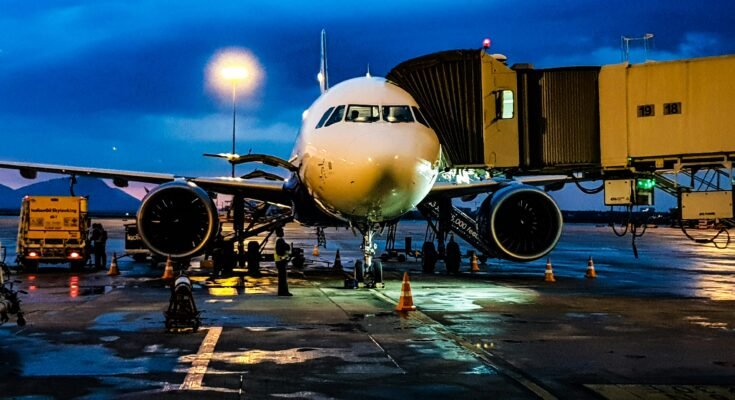The aviation industry keeps evolving at a pace that would astound the pioneers of flight, with cutting-edge technologies transforming every aspect of how aircraft are designed, operated, and maintained. Sure, you’ll notice the obvious improvements, those slick entertainment systems and surprisingly comfortable seats, but what about the innovations working quietly behind the scenes? These technological leaps represent years of dedicated research and engineering brilliance, all aimed at making air travel safer, more efficient, and kinder to our planet. From materials that seem straight out of science fiction to artificial intelligence that’s learning to predict problems before they happen, aviation is experiencing what can only be described as a technological renaissance. The changes underway today promise to fundamentally reshape how we’ll experience air transportation for generations to come.
Advanced Composite Materials Revolutionizing Aircraft Construction
Walk up to a modern airliner and you’re looking at something that would seem almost alien to aircraft engineers from just a few decades ago. Today’s aircraft increasingly rely on advanced composite materials offering strength-to-weight ratios that traditional aluminum simply can’t match. Carbon fiber reinforced polymers now make up nearly half of the airframe in next-generation commercial aircraft, which translates into substantial weight reductions, and weight savings mean fuel savings and the ability to fly farther on the same tank. What’s particularly impressive about these materials is their superior fatigue resistance, allowing aircraft to endure countless flight cycles without developing the structural weaknesses that eventually plague metal components.
Electric and Hybrid-Electric Propulsion Systems
If you think electric vehicles are shaking up the automotive world, wait until you see what’s happening in aviation. The development of electric and hybrid-electric propulsion represents one of the most transformative technological frontiers in flight, offering genuine potential to slash carbon emissions and operating costs. Several manufacturers have already successfully tested all-electric aircraft for regional routes, and battery technology is advancing at a pace that makes practical flight durations for short-haul operations increasingly realistic. Hybrid-electric systems take a different approach, combining traditional turbine engines with electric motors to optimize power sources based on what the aircraft needs during different flight phases, electric power handles taxi, takeoff, and landing, while conventional engines take over for cruise efficiency.
Artificial Intelligence for Predictive Maintenance
Here’s where things get really interesting, artificial intelligence and machine learning are completely changing how airlines approach aircraft maintenance. Think about this: modern aircraft generate terabytes of operational data through thousands of sensors constantly monitoring everything from engine performance to hydraulic pressure. AI systems analyze these massive data streams in real-time, detecting subtle anomalies that indicate problems brewing beneath the surface. This predictive approach represents a fundamental shift from the old reactive model, allowing maintenance teams to address issues during scheduled downtime rather than scrambling to respond when something fails unexpectedly and causes costly delays.
Next-Generation Cockpit Technologies and Enhanced Vision Systems
Step into a modern cockpit and you’ll find technology that would make previous generations of pilots shake their heads in amazement. Enhanced vision systems now provide pilots with situational awareness that works in all weather conditions, transcending the limitations that Mother Nature used to impose. Synthetic vision technology generates three-dimensional terrain displays pulled from database information, giving pilots crystal-clear visual references even when they’re flying through clouds or darkness that would completely obscure natural visibility. Infrared cameras add another dimension entirely, detecting heat signatures to identify runways, obstacles, and other aircraft through fog, rain, or smoke that would defeat conventional vision, with all that imagery displayed right on cockpit screens or projected onto head-up displays. These systems weave together real-time traffic information, weather data, and terrain alerts into unified displays that actually reduce pilot workload while sharpening decision-making capabilities during critical flight phases. Touchscreen interfaces have largely replaced the maze of mechanical switches and knobs that used to characterize aircraft systems, providing intuitive controls that feel familiar while simultaneously reducing cockpit complexity and weight. The latest head-up display systems project essential flight information directly onto the windscreen at the pilot’s eye level, allowing them to keep their eyes outside while monitoring critical parameters, a capability that proves invaluable during challenging approaches and landings. Maintaining optimal visibility remains crucial during all flight operations, which is why pilots rely on specialized products like prist windshield cleaner to ensure windscreens stay clear regardless of weather conditions they encounter.
Advanced Aerodynamic Innovations
Aerodynamics might sound like dry physics, but the innovations in this field are delivering efficiency gains that have real-world impact on both economics and environmental performance. Winglets and their more sophisticated relatives, blended winglets and raked wingtips, minimize induced drag by managing how air flows at wing tips, where pressure differences create wasteful vortices that literally drag efficiency down. Active flow control systems take things up a notch, using carefully directed jets of air or mechanical devices to manipulate boundary layer airflow and maintain laminar flow over larger portions of the wing surface, reducing the skin friction drag that quietly consumes fuel. Adaptive wing technologies represent an even more ambitious approach, enabling real-time adjustments to wing shape and configuration based on current flight conditions to optimize performance whether cruising at altitude or maneuvering at lower speeds.
Sustainable Aviation Fuels and Green Technologies
Aviation’s relationship with environmental sustainability has shifted dramatically, with the industry making substantial progress through alternative fuels and green technologies that reduce its carbon footprint without sacrificing the performance passengers and airlines depend on. Sustainable aviation fuels derived from renewable sources like agricultural waste, algae, and even municipal solid waste can slash lifecycle carbon emissions by up to eighty percent compared to conventional jet fuel. What makes these fuels particularly practical is that they meet existing specifications and work in current aircraft without any modifications, enabling immediate adoption as production scales up to meet growing demand. Advanced winglet designs and comprehensive weight-reduction initiatives complement these fuel improvements, with airlines implementing programs that address everything from lighter galley equipment to optimized flight planning that shaves unnecessary fuel consumption.
Conclusion
These seven technological advancements barely scratch the surface of the innovation that’s transforming aviation into a safer, more efficient, and environmentally responsible industry. From revolutionary materials and propulsion systems to artificial intelligence applications and sustainable practices, each advancement plays its part in an integrated ecosystem of continuous improvement. Passengers might not directly observe many of these technologies during their travels, but they’re definitely benefiting from the enhanced safety, reliability, and environmental stewardship these innovations deliver. As research marches forward and emerging technologies mature, the aviation industry will undoubtedly introduce even more remarkable capabilities that further revolutionize how we experience air transportation.




